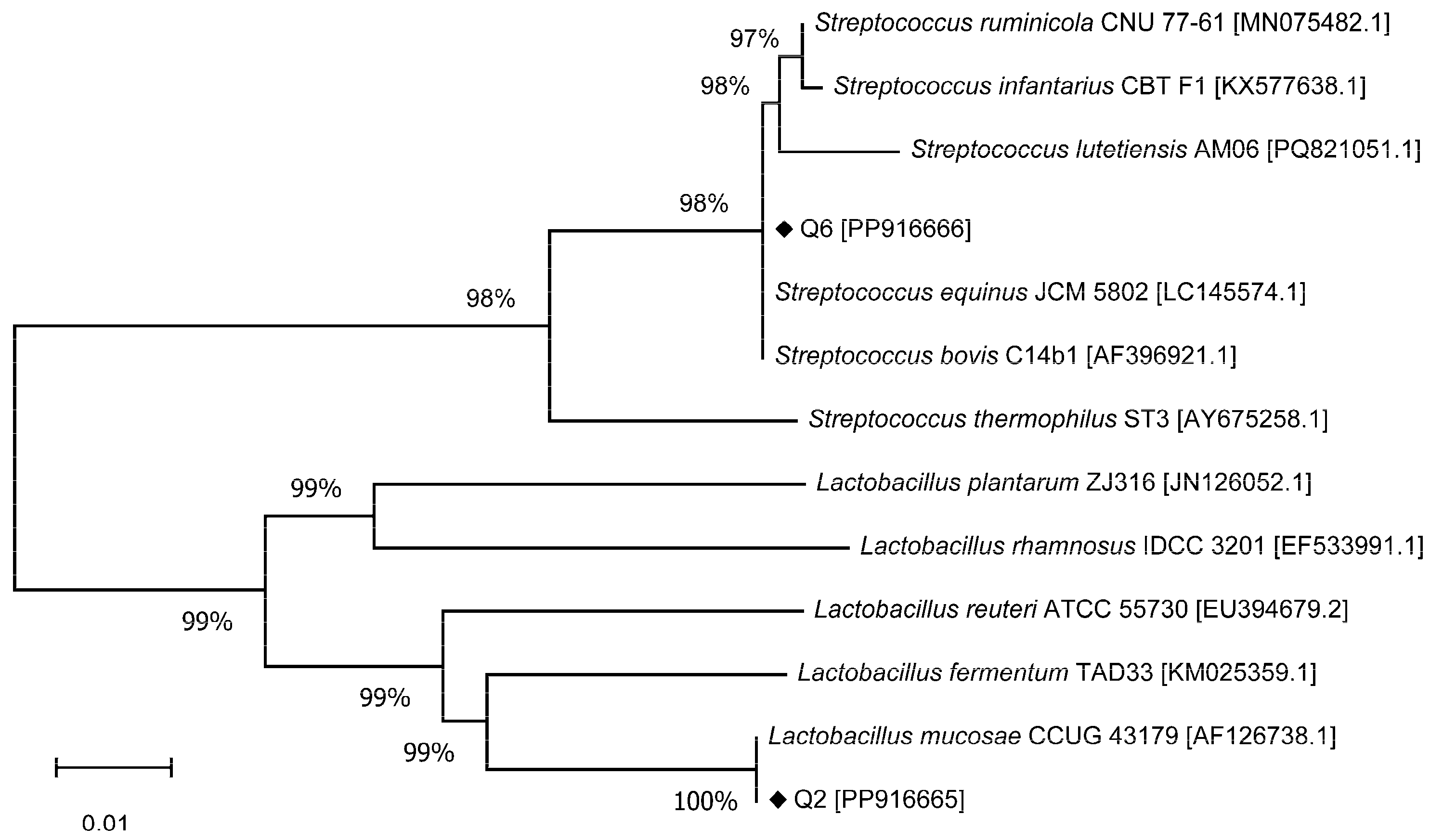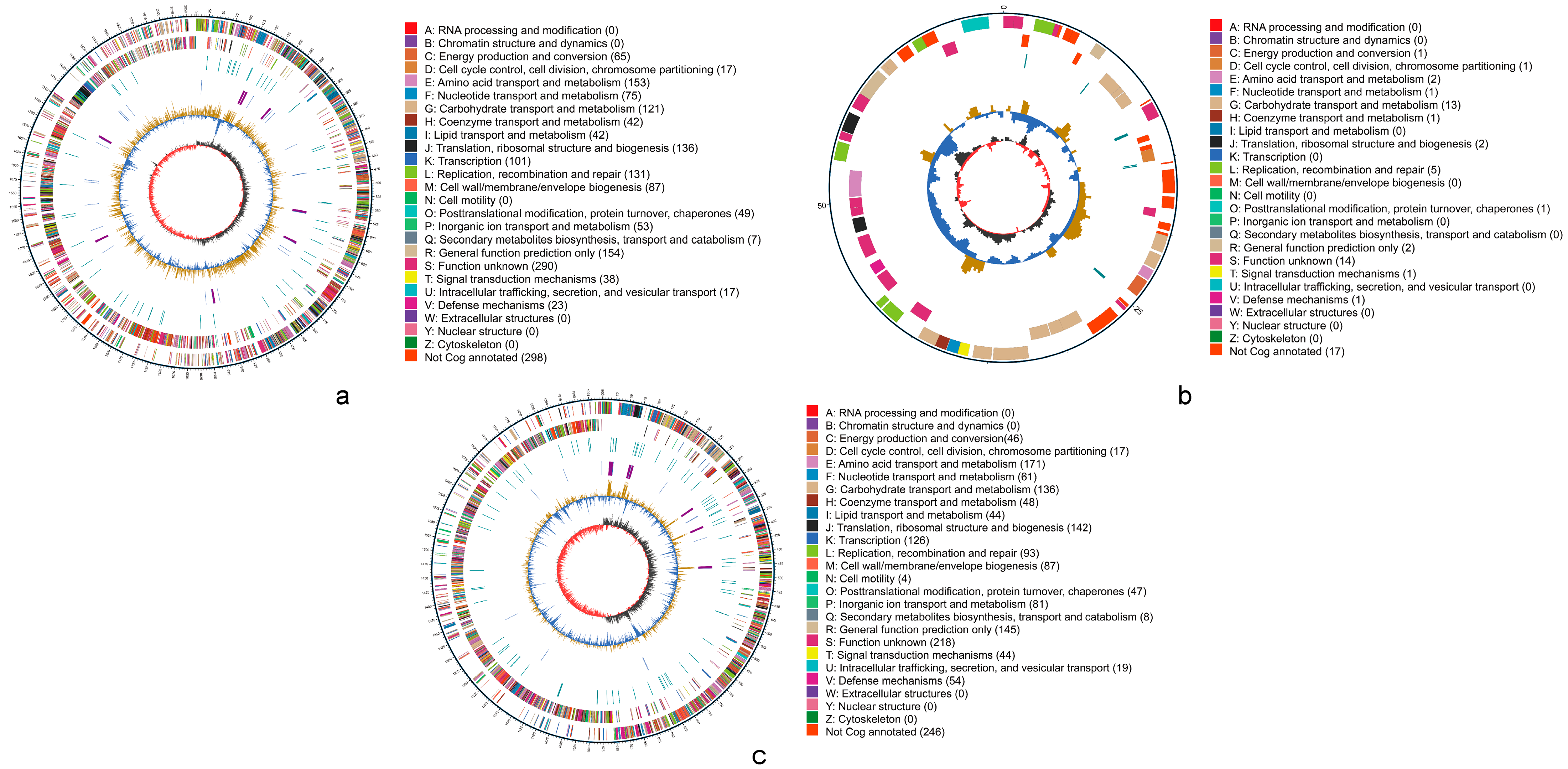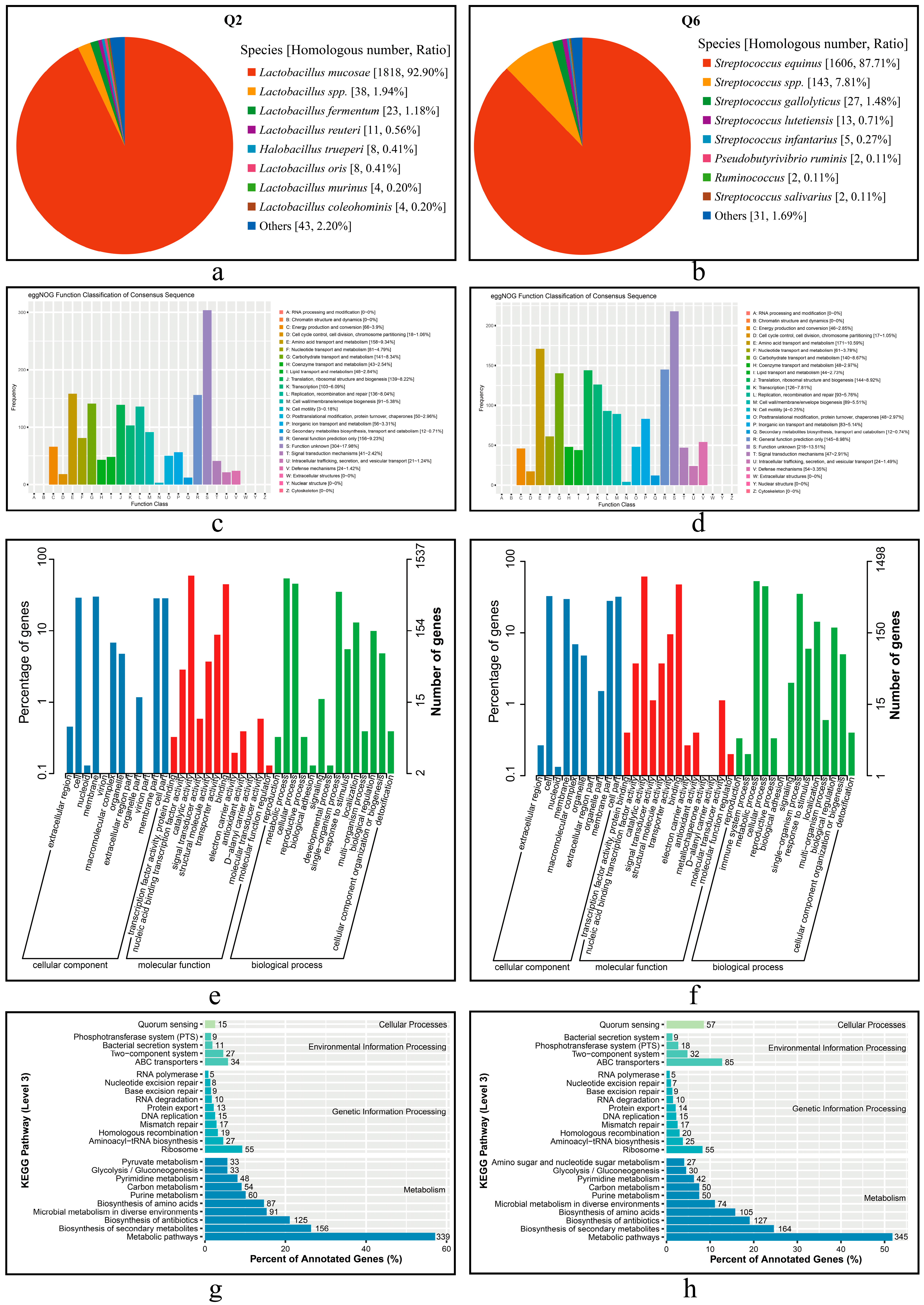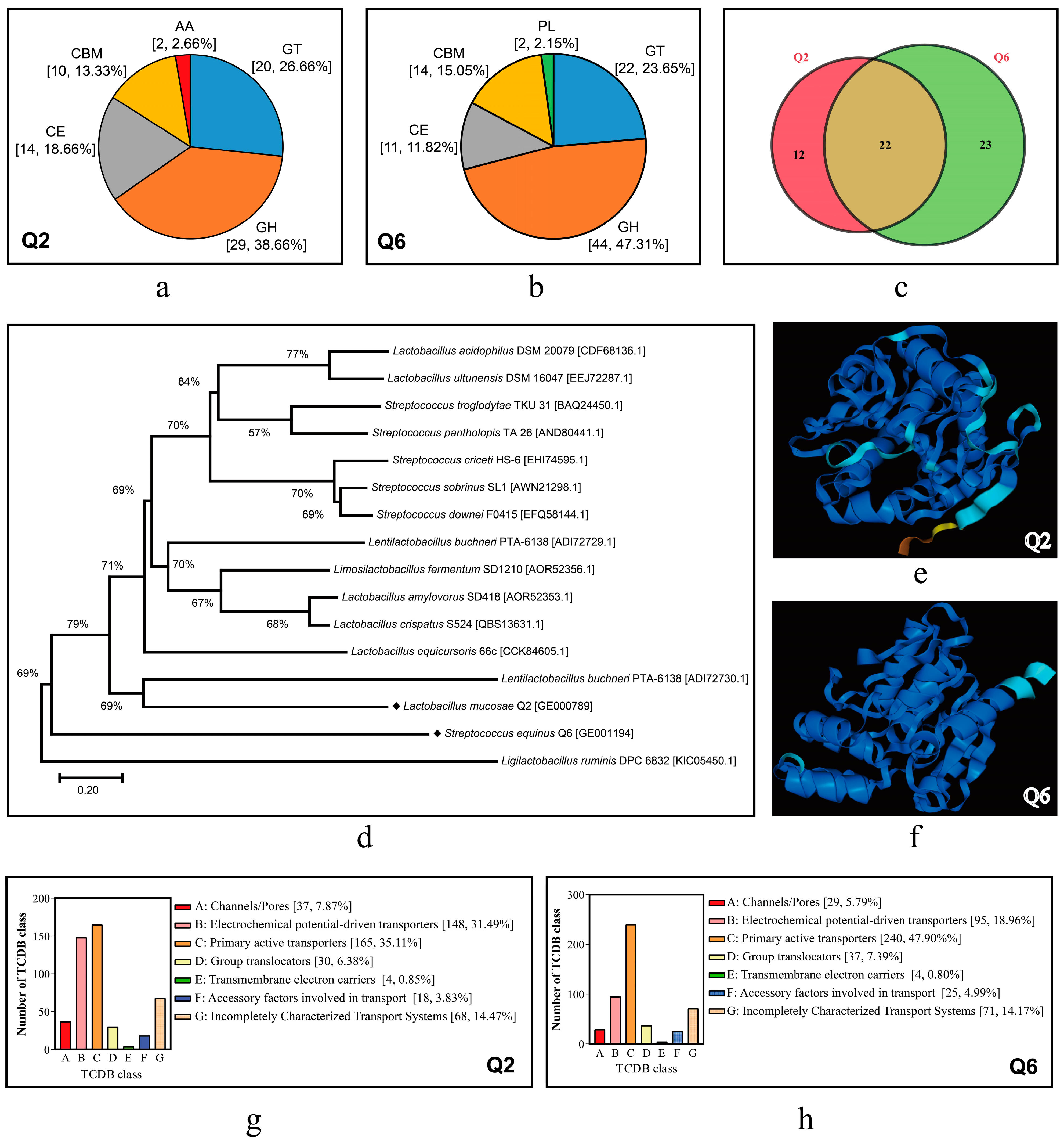Screening, Identification, and Whole-Genome Sequencing of Ferulic Acid Esterase-Producing Lactic Acid Bacteria from Sheep Rumen
Abstract
1. Introduction
2. Materials and Methods
2.1. Reagents, Media, and Strains
2.2. Screening of Ferulic Acid Esterase-Producing Lactic Acid Bacteria
2.3. Determination of FAE Activity
2.4. 16S rDNA Identification
2.5. Carbohydrate Fermentation Test
2.6. Growth Kinetics and Lactate Production
2.7. Antimicrobial Activity
2.8. Whole Genome Sequencing and Bioinformatics Analysis
2.8.1. Genomic DNA Extraction, Sequencing, Quality Control, and Assembly
2.8.2. Bioinformatics Analysis
2.9. Data Analysis
3. Results
3.1. Screening of FAE-Producing Strains
3.2. 16S rDNA Sequence Alignment
3.3. Carbohydrate Utilization
3.4. Growth Curves, pH Dynamics and Lactate Production Profiles
3.5. Antimicrobial Activity Against Pathogenic Bacteria
3.6. Whole Genome Sequencing
3.6.1. Genome Sequencing, Assembly, and Gene Prediction
3.6.2. Gene Annotation in Universal Databases
3.6.3. Gene Annotation in Special Databases
4. Discussion
5. Conclusions
Supplementary Materials
Author Contributions
Funding
Institutional Review Board Statement
Informed Consent Statement
Data Availability Statement
Conflicts of Interest
Abbreviations
| FAE | ferulic acid esterase |
| LAB | lactic acid bacteria |
| LB | Luria-Bertani |
| CDSs | coding sequences |
| CAZy | carbohydrate-active enzymes database |
| FA | ferulic acid |
| CE | carbohydrate esterases |
| MOPS | 3-(N-morpholino) propanesulfonic acid |
| MRS | The de Man, Rogosa, and Sharpe |
| ANI | average nucleotide identity |
| CRISPR | clustered regularly interspaced palindromic repeats |
| TCDB | Transporter Classification Database |
| Nr | Non-Redundant Protein Sequence Database |
| GO | Gene Ontology |
| KEGG | Kyoto Encyclopedia of Genes and Genomes |
| eggNOG | evolutionary genealogy of genes: Non-supervised Orthologous Groups |
| ARGs | antibiotic resistance genes |
| RGI | Resistance Gene Identifier |
| VFDB | virulence factor database |
| VFGs | virulence factor genes |
| AMPs | antimicrobial peptides |
| PGs | pathogenic genes |
| PPRS | probiotic potential risk score |
| CC | cellular component |
| BP | biological process |
| COGs | Clusters of Orthologous Groups |
| CAZymes | carbohydrate-active enzymes |
| GHs | glycoside hydrolases |
| GTs | glycosyl transferases |
| AAs | auxiliary activities |
| PLs | polysaccharide lyases |
| ldh | lactate dehydrogenase gene |
| ldhL | L-lactate dehydrogenase gene |
| ldhD | D-lactate dehydrogenase gene |
| SBSEC | Streptococcus bovis/Streptococcus equinus complex |
| BV-BRC | Bacterial and Viral Bioinformatics Resource Center |
| MGMT | methylated-DNA-protein-cysteine methyltransferase |
| frdA | flavoprotein subunit |
References
- Guo, H.; Zhao, Y.; Chang, J.S.; Lee, D.J. Enzymes and enzymatic mechanisms in enzymatic degradation of lignocellulosic biomass: A mini-review. Bioresour. Technol. 2023, 367, 128252. [Google Scholar] [CrossRef] [PubMed]
- Riseh, R.S.; Fathi, F.; Lagzian, A.; Vatankhah, M.; Kennedy, J.F. Modifying lignin: A promising strategy for plant disease control. Int. J. Biol. Macromol. 2024, 271 Pt 2, 132696. [Google Scholar] [CrossRef]
- Wang, R.; Yang, H.J.; Yang, X.; Cao, B.H. Four phenolic acids determined by an improved HPLC method with a programmed ultraviolet wavelength detection and their relationships with lignin content in 13 agricultural residue feeds. J. Sci. Food Agric. 2013, 93, 53–60. [Google Scholar] [CrossRef]
- Terrett, O.M.; Dupree, P. Covalent interactions between lignin and hemicelluloses in plant secondary cell walls. Curr. Opin. Biotechnol. 2019, 56, 97–104. [Google Scholar] [CrossRef] [PubMed]
- Grabber, J.H.; Ralph, J.; Hatfield, R.D. Ferulate cross-links limit the enzymatic degradation of synthetically lignified primary walls of maize. J. Agric. Food Chem. 1998, 46, 2609–2614. [Google Scholar] [CrossRef]
- Oliveira, D.M.; Mota, T.R.; Oliva, B.; Segato, F.; Marchiosi, R.; Ferrarese-Filho, O.; Faulds, C.B.; Dos Santos, W.D. Feruloyl esterases: Biocatalysts to overcome biomass recalcitrance and for the production of bioactive compounds. Bioresour. Technol. 2019, 278, 408–423. [Google Scholar] [CrossRef]
- Underlin, E.N.; Frommhagen, M.; Dilokpimol, A.; van Erven, G.; de Vries, R.P.; Kabel, M.A. Feruloyl esterases for biorefineries: Subfamily classified specificity for natural substrates. Front. Bioeng. Biotechnol. 2020, 8, 332. [Google Scholar] [CrossRef]
- Wang, Q.Y.; Liu, X.J.; Hou, Y.H.; Wang, J.Z.; Lin, M.Z.; Yang, Q.Z. Characterization of heat- and alkali-resistant feruloyl esterase from Humicola insolens and application in the production of high-strength kraft straws. Int. J. Biol. Macromol. 2024, 283 Pt 2, 137742. [Google Scholar] [CrossRef]
- Kanelias, K.; Mould, F.L. The effect of ferulic acid esterase on the in vitro degradability of wheat straw. Proc. Br. Soc. Anim. Sci. 2006, 2006, 189. [Google Scholar]
- Yang, H.; Li, D.; Xie, C.; Yue, Q. Effects of ferulic acid esterase supplementation on rumen fermentation characteristics of Chinese wildrye, corn stalk, rice straw and wheat straw by in vitro batch culture. Chin. J. Anim. Nutri. 2010, 22, 207–211. [Google Scholar] [CrossRef]
- Yu, Q.; Xu, J.; Li, M.; Xi, Y.; Sun, H.; Xie, Y.; Cheng, Q.; Li, P.; Chen, C.; Yang, F.; et al. Synergistic effects of ferulic acid esterase-producing lactic acid bacteria, cellulase and xylanase on the fermentation characteristics, fibre and nitrogen components and microbial community structure of Broussonetia papyrifera during ensiling. J. Sci. Food Agric. 2024, 104, 3543–3558. [Google Scholar] [CrossRef]
- Liu, Q.; Zhou, D.Y.; Chen, L.; Dong, R.Q.; Zhuang, S. Effects of feruloyl esterase, non-starch polysaccharide degrading enzymes, phytase, and their combinations on in vitro degradation of rice bran and nutrient digestibility of rice bran based diets in adult cockerels. Livest. Sci. 2015, 178, 255–262. [Google Scholar] [CrossRef]
- Wang, L.; Chen, P.; Luo, Y.; Li, X. Enzymatic fermented feed by the feruloyl esterases: Quality and effects on the performance of broilers. Chin. J. Anim. Nutri. 2015, 27, 1540–1548. [Google Scholar] [CrossRef]
- Luo, Y.; Wang, Z.; Mei, S.; Chen, P.; Li, X. Effect of ferulic acid esterase fermentative feed on the ternary pigs. J. Food Sci. Biotechnol. 2018, 37, 527–534. [Google Scholar] [CrossRef]
- Cheng, Y.; Ma, J.; Zhu, W. Mechanism of feruloyl esterase promoting degradation of crude fiber and its application in feed industry. Chin. J. Anim. Nutri. 2022, 34, 6203–6212. [Google Scholar] [CrossRef]
- Andrada, E.; Abeijón-Mukdsi, M.C.; Vinderola, G.; Medina, R.B. Ferulic acid esterase-producing Lactobacilli as silage inoculants: A review on the efficacy of improving fiber composition and digestibility of forages. Fermentation 2024, 10, 614. [Google Scholar] [CrossRef]
- Donaghy, J.; Kelly, P.F.; McKay, A.M. Detection of ferulic acid esterase production by Bacillus spp. and Lactobacilli. Appl. Microbiol. Biotechnol. 1998, 50, 257–260. [Google Scholar] [CrossRef]
- Yue, Q.; Yang, H.J.; Cao, Y.C.; Zhang, D.F.; Jiang, Y.H.; Wang, J.Q. Feruloyl and acetyl esterase production of an anaerobic rumen fungus Neocallimastix sp. YQ2 effected by glucose and soluble nitrogen supplementations and its potential in the hydrolysis of fibrous feedstuffs. Anim. Feed Sci. Technol. 2009, 153, 263–277. [Google Scholar] [CrossRef]
- Karaseva, O.; Ozhegov, G.; Khusnutdinova, D.; Siniagina, M.; Anisimova, E.; Akhatova, F.; Fakhrullin, R.; Yarullina, D. Whole genome sequencing of the novel probiotic strain Lactiplantibacillus plantarum FCa3L. Microorganisms 2023, 11, 1234. [Google Scholar] [CrossRef]
- Vanhee, M.; Floré, K.; Vanthourenhout, S.; Hellemans, J.; Muyldermans, A.; Reynders, M. Implementation of full-length 16S nanopore sequencing for bacterial identification in a clinical diagnostic setting. Diagn. Microbiol. Infect. Dis. 2024, 108, 116156. [Google Scholar] [CrossRef]
- Tamura, K.; Stecher, G.; Kumar, S. MEGA11: Molecular evolutionary genetics analysis version 11. Mol. Biol. Evol. 2021, 38, 3022–3027. [Google Scholar] [CrossRef]
- Rabha, M.; Das, D.; Konwar, T.; Acharjee, S.; Sarmah, B.K. Whole genome sequencing of a novel Bacillus thuringiensis isolated from Assam soil. BMC Microbiol. 2023, 23, 91. [Google Scholar] [CrossRef]
- Alcock, B.P.; Huynh, W.; Chalil, R.; Smith, K.W.; Raphenya, A.R.; Wlodarski, M.A.; Edalatmand, A.; Petkau, A.; Syed, S.A.; Tsang, K.K.; et al. CARD 2023: Expanded curation, support for machine learning, and resistome prediction at the Comprehensive Antibiotic Resistance Database. Nucleic Acids Res. 2023, 51, D690–D699. [Google Scholar] [CrossRef]
- Chen, C.; Wu, Y.; Li, J.; Wang, X.; Zeng, Z.; Xu, J.; Liu, Y.; Feng, J.; Chen, H.; He, Y.; et al. TBtools-II: A “one for all, all for one” bioinformatics platform for biological big-data mining. Mol. Plant 2023, 16, 1733–1742. [Google Scholar] [CrossRef]
- Zhou, S.; Liu, B.; Zheng, D.; Chen, L.; Yang, J. VFDB 2025: An integrated resource for exploring anti-virulence compounds. Nucleic Acids Res. 2025, 53, D871–D877. [Google Scholar] [CrossRef] [PubMed]
- Yao, L.; Guan, J.; Xie, P.; Chung, C.R.; Zhao, Z.; Dong, D.; Guo, Y.; Zhang, W.; Deng, J.; Pang, Y.; et al. dbAMP 3.0: Updated resource of antimicrobial activity and structural annotation of peptides in the post-pandemic era. Nucleic Acids Res. 2025, 53, D364–D376. [Google Scholar] [CrossRef] [PubMed]
- Urban, M.; Cuzick, A.; Seager, J.; Nonavinakere, N.; Sahoo, J.; Sahu, P.; Iyer, V.L.; Khamari, L.; Martinez, M.C.; Hammond-Kosack, K.E. PHI-base–the multi-species pathogen-host interaction database in 2025. Nucleic Acids Res. 2025, 53, D826–D838. [Google Scholar] [CrossRef] [PubMed]
- Sun, Y.; Li, H.; Zheng, L.; Li, J.; Hong, Y.; Liang, P.; Kwok, L.Y.; Zuo, Y.; Zhang, W.; Zhang, H. iProbiotics: A machine learning platform for rapid identification of probiotic properties from whole-genome primary sequences. Brief. Bioinform. 2022, 23, bbab477. [Google Scholar] [CrossRef]
- Liu, Y.Y.; Hsu, C.Y.; Yang, Y.C.; Huang, C.H.; Chen, C.C. ProbioMinServer: An integrated platform for assessing the safety and functional properties of potential probiotic strains. Bioinform. Adv. 2023, 3, vbad153. [Google Scholar] [CrossRef]
- Zheng, J.; Wittouck, S.; Salvetti, E.; Franz, C.M.A.P.; Harris, H.M.B.; Mattarelli, P.; O’Toole, P.W.; Pot, B.; Vandamme, P.; Walter, J.; et al. A taxonomic note on the genus Lactobacillus: Description of 23 novel genera, emended description of the genus Lactobacillus Beijerinck 1901, and union of Lactobacillaceae and Leuconostocaceae. Int. J. Syst. Evol. Microbiol. 2020, 70, 2782–2858. [Google Scholar] [CrossRef]
- Corredoira, J.; Rabuñal, R.; Alonso, M.P. Streptococcus bovis: 100 Years of an intriguing pathogen. Clin. Microbiol. Newsl. 2017, 39, 1–9. [Google Scholar] [CrossRef]
- Stewart, C.S. Lactic acid bacteria in the rumen. In The Lactic Acid Bacteria; Wood, B.J.B., Ed.; Springer: Berlin/Heidelberg, Germany, 1992; Volume 1, pp. 49–68. [Google Scholar] [CrossRef]
- Matthews, C.; Crispie, F.; Lewis, E.; Reid, M.; O’Toole, P.W.; Cotter, P.D. The rumen microbiome: A crucial consideration when optimising milk and meat production and nitrogen utilisation efficiency. Gut Microbes 2019, 10, 115–132. [Google Scholar] [CrossRef] [PubMed]
- Feng, Y.L. Ruminant Nutrition; Science Press: Beijing, China, 2004; pp. 11–13. [Google Scholar]
- Orla-Jensen, S. The Lactic Acid Bacteria; Host: Copenhagen, Denmark, 1919; pp. 1–196. [Google Scholar]
- Poyart, C.; Quesne, G.; Trieu-Cuot, P. Taxonomic dissection of the Streptococcus bovis group by analysis of manganese dependent superoxide dismutase gene (sodA) sequences: Reclassification of ‘Streptococcus infantarius subsp. coli’ as Streptococcus lutetiensis sp. nov. and of Streptococcus bovis biotype II. 2 as Streptococcus pasteurianus sp. nov. Int. J. Syst. Evol. Microbiol. 2002, 52, 1247–1255. [Google Scholar] [CrossRef] [PubMed]
- Jans, C.; Meile, L.; Lacroix, C.; Stevens, M.J. Genomics, evolution, and molecular epidemiology of the Streptococcus bovis/Streptococcus equinus complex (SBSEC). Infect. Genet. Evol. 2015, 33, 419–436. [Google Scholar] [CrossRef]
- Park, S.Y.; Lee, M.; Lim, S.R.; Kwon, H.; Lee, Y.S.; Kim, J.H.; Seo, S. Diversity and antimicrobial resistance in the Streptococcus bovis/Streptococcus equinus complex (SBSEC) isolated from Korean domestic ruminants. Microorganisms 2021, 9, 98. [Google Scholar] [CrossRef]
- Roos, S.; Karner, F.; Axelsson, L.; Jonsson, H. Lactobacillus mucosae sp. nov., a new species with in vitro mucus-binding activity isolated from pig intestine. Int. J. Syst. Evol. Microbiol. 2000, 50 Pt 1, 251–258. [Google Scholar] [CrossRef] [PubMed]
- London, L.E.; Price, N.P.; Ryan, P.; Wang, L.; Auty, M.A.; Fitzgerald, G.F.; Stanton, C.; Ross, R.P. Characterization of a bovine isolate Lactobacillus mucosae DPC 6426 which produces an exopolysaccharide composed predominantly of mannose residues. J. Appl. Microbiol. 2014, 117, 509–517. [Google Scholar] [CrossRef]
- Yu, X.; Li, S.; Yang, D.; Qiu, L.; Wu, Y.; Wang, D.; Shah, N.P.; Xu, F.; Wei, H. A novel strain of Lactobacillus mucosae isolated from a Gaotian villager improves in vitro and in vivo antioxidant as well as biological properties in D-galactose-induced aging mice. J. Dairy Sci. 2016, 99, 903–914. [Google Scholar] [CrossRef]
- de Moraes, G.M.D.; de Abreu, L.R.; do Egito, A.S.; Salles, H.O.; da Silva, L.M.F.; Nero, L.A.; Todorov, S.D.; Dos Santos, K.M.O. Functional properties of Lactobacillus mucosae strains isolated from Brazilian goat milk. Probiotics Antimicrob. Proteins 2017, 9, 235–245. [Google Scholar] [CrossRef]
- Repally, A.; Perumal, V.; Dasari, A.; Palanichamy, E.; Venkatesan, A. Isolation, identification of Lactobacillus mucosae AN1 and its antilisterial peptide purification and characterization. Probiotics Antimicrob. Proteins 2018, 10, 775–786. [Google Scholar] [CrossRef]
- Rastogi, S.; Mittal, V.; Singh, A. In Vitro evaluation of probiotic potential and safety assessment of Lactobacillus mucosae strains isolated from donkey’s lactation. Probiotics Antimicrob. Proteins 2020, 12, 1045–1056. [Google Scholar] [CrossRef]
- Lee, J.H.; Valeriano, V.D.; Shin, Y.R.; Chae, J.P.; Kim, G.B.; Ham, J.; Chun, J.; Kang, D.K. Genome sequence of Lactobacillus mucosae LM1, isolated from piglet feces. J. Bacteriol. 2012, 194, 4766. [Google Scholar] [CrossRef]
- Bleckwedel, J.; Terán, L.C.; Bonacina, J.; Saavedra, L.; Mozzi, F.; Raya, R.R. Draft genome sequence of the mannitol-producing strain Lactobacillus mucosae CRL573. Genome Announc. 2014, 2, e01292-14. [Google Scholar] [CrossRef] [PubMed]
- Ryan, P.M.; Guinane, C.M.; London, L.E.; Kelleher, P.R.; Fitzgerald, G.F.; Caplice, N.M.; Ross, R.P.; Stanton, C. Genome sequence of the heteropolysaccharide-producing strain Lactobacillus mucosae DPC 6426. Genome Announc. 2015, 3, e01350-14. [Google Scholar] [CrossRef] [PubMed]
- Olson, R.D.; Assaf, R.; Brettin, T.; Conrad, N.; Cucinell, C.; Davis, J.J.; Dempsey, D.M.; Dickerman, A.; Dietrich, E.M.; Kenyon, R.W.; et al. Introducing the Bacterial and Viral Bioinformatics Resource Center (BV-BRC): A resource combining PATRIC, IRD and ViPR. Nucleic Acids Res. 2023, 51, D678–D689. [Google Scholar] [CrossRef] [PubMed]
- Benahmed, F.H.; Gopinath, G.R.; Harbottle, H.; Cotta, M.A.; Luo, Y.; Henderson, C.; Teri, P.; Soppet, D.; Rasmussen, M.; Whitehead, T.R.; et al. Draft genome sequences of Streptococcus bovis strains ATCC 33317 and JB1. Genome Announc. 2014, 2, e01012-14. [Google Scholar] [CrossRef]
- Ghattargi, V.C.; Gaikwad, M.A.; Meti, B.S.; Nimonkar, Y.S.; Dixit, K.; Prakash, O.; Shouche, Y.S.; Pawar, S.P.; Dhotre, D.P. Comparative genome analysis reveals key genetic factors associated with probiotic property in Enterococcus faecium strains. BMC Genomics. 2018, 19, 652. [Google Scholar] [CrossRef]
- Kavanova, K.; Kostovova, I.; Moravkova, M.; Kubasova, T.; Crhanova, M. In vitro characterization of lactic acid bacteria and bifidobacteria from wild and domestic pigs: Probiotic potential for post-weaning piglets. BMC Microbiol. 2025, 25, 8. [Google Scholar] [CrossRef]
- Gobbetti, M.; Calasso, M. Streptococcus Introduction. In Encyclopedia of Food Microbiology, 2nd ed.; Batt, C.A., Tortorello, M.L., Eds.; Academic Press: Cambridge, MA, USA, 2014; pp. 535–553. [Google Scholar] [CrossRef]
- Gatto, V.; Binati, R.L.; Junior, W.J.F.L.; Basile, A.; Treu, L.; de Almeida, O.G.G.; Innocente, G.; Campanaro, S.; Torriani, S. New insights into the variability of lactic acid production in Lachancea thermotolerans at the phenotypic and genomic level. Microbiol. Res. 2020, 238, 126525. [Google Scholar] [CrossRef]
- Yang, F.; Zhang, Q.; Liu, Y.; Li, J.; Wang, L.; Chen, J. Lactic acid biosynthesis pathways and important genes of Lactobacillus panis L7 isolated from the Chinese liquor brewing microbiome. Food Biosci. 2020, 36, 100627. [Google Scholar] [CrossRef]
- Shi, Q.; Ma, J.; Abdel-Hamid, A.M.; Li, Y.; Zhong, P.; Wang, D.; Sun, Z.; Tu, T.; Zhu, W.; Cheng, Y.; et al. Mining of latent feruloyl esterase resources in rumen and insight into dual-functional feruloyl esterase-xylanase from Pecoramyces ruminantium F1. Bioresour. Technol. 2025, 418, 131854. [Google Scholar] [CrossRef] [PubMed]
- Wang, Y.L.; Wang, W.K.; Wu, Q.C.; Yang, H.J. The release and catabolism of ferulic acid in plant cell wall by rumen microbes: A review. Anim. Nutr. 2022, 9, 335–344. [Google Scholar] [CrossRef]
- Wong, D.W.S.; Chan, V.J.; Liao, H. Metagenomic discovery of feruloyl esterases from rumen microflora. Appl. Microbiol. Biotechnol. 2019, 103, 8449–8457. [Google Scholar] [CrossRef]
- Darbandi, A.; Asadi, A.; Ari, M.M.; Ohadi, E.; Talebi, M.; Zadeh, M.H.; Emamie, A.D.; Ghanavati, R.; Kakanj, M. Bacteriocins: Properties and potential use as antimicrobials. J. Clin. Lab. Anal. 2022, 36, e24093. [Google Scholar] [CrossRef] [PubMed]
- Joachimsthal, E.L.; Reeves, R.K.; Hung, J.; Nielsen, L.K.; Ouwerkerk, D.; Klieve, A.V.; Vickers, C.E. Production of bacteriocins by Streptococcus bovis strains from Australian ruminants. J. Appl. Microbiol. 2010, 108, 428–436. [Google Scholar] [CrossRef] [PubMed]
- Watanabe, M.; Kinoshita, H.; Nitta, M.; Yukishita, R.; Kawai, Y.; Kimura, K.; Taketomo, N.; Yamazaki, Y.; Tateno, Y.; Miura, K.; et al. Identification of a new adhesin-like protein from Lactobacillus mucosae ME-340 with specific affinity to the human blood group A and B antigens. J. Appl. Microbiol. 2010, 109, 927–935. [Google Scholar] [CrossRef]
- Drissi, F.; Merhej, V.; Blanc-Tailleur, C.; Raoult, D. Draft genome sequence of the Lactobacillus mucosae strain Marseille. Genome Announc. 2015, 3, e00841-15. [Google Scholar] [CrossRef]
- Chen, W.C.; Juang, R.S.; Wei, Y.H. Applications of a lipopeptide biosurfactant, surfactin, produced by microorganisms. Biochem. Eng. J. 2015, 103, 158–169. [Google Scholar] [CrossRef]
- Oftedal, T.F.; Ovchinnikov, K.V.; Hestad, K.A.; Goldbeck, O.; Porcellato, D.; Narvhus, J.; Riedel, C.U.; Kjos, M.; Diep, D.B. Ubericin K, a new pore-forming bacteriocin targeting mannose-PTS. Microbiol. Spectr. 2021, 9, e0029921. [Google Scholar] [CrossRef]
- De Zanine, A.M.; Bonelli, E.A.; Ferreira, D.J.; Souza, A.L.; Santos, E.M.; Pinho, R.M.A.; Parente, H.N.; Parente, M.O.M. Fermentation and chemical composition of guinea grass silage added with wheat meal and Streptococcus bovis. N. Z. J. Agric. Res. 2018, 61, 487–494. [Google Scholar] [CrossRef]
- De Zanine, A.M.; Bonelli, E.A.; Souza, A.L.; de Ferreira, D.J.; Santos, E.M.; Ribeiro, M.D.; Geron, L.J.V.G.; Pinho, R.M.A. Effects of Streptococcus bovis isolated from bovine rumen on the fermentation characteristics and nutritive value of Tanzania grass silage. Sci. World J. 2016, 2016, 8517698. [Google Scholar] [CrossRef] [PubMed][Green Version]
- Niu, Y.; Guo, Y.; Huang, R.; Niu, J.; Wang, Y.; Zhang, P.; Lu, Q.; Zhang, W. Fermentative profile and bacterial community structure of whole-plant triticale silage (Triticosecale Wittmack) with or without the addition of Streptococcus bovis and Lactiplantibacillus plantarum. mSphere 2025, 10, e0089424. [Google Scholar] [CrossRef] [PubMed]
- Guo, Y.; Huang, R.; Niu, Y.; Zhang, P.; Li, Y.; Zhang, W. Chemical characteristics, antioxidant capacity, bacterial community, and metabolite composition of mulberry silage ensiling with lactic acid bacteria. Front. Microbiol. 2024, 15, 1363256. [Google Scholar] [CrossRef] [PubMed]
- De Ferreira, D.J.; de Lana, R.P.; de Zanine, A.M.; Santos, E.M.; Veloso, C.M.; Ribeiro, G.A. Silage fermentation and chemical composition of elephant grass inoculated with rumen strains of Streptococcus bovis. Anim. Feed Sci. Technol. 2013, 183, 22–28. [Google Scholar] [CrossRef]
- Jones, B.A.; Muck, R.E.; Ricke, S.C. Selection and application of Streptococcus bovis as a silage inoculant. Appl. Environ. Microbiol. 1991, 57, 3000–3005. [Google Scholar] [CrossRef]
- Hu, G.; Jiang, H.; Zong, Y.; Datsomor, O.; Kou, L.; An, Y.; Zhao, J.; Miao, L. Characterization of lactic acid-producing bacteria isolated from rumen: Growth, acid and bile salt tolerance, and antimicrobial function. Fermentation 2022, 8, 385. [Google Scholar] [CrossRef]







| Strains (Accession No.) | The Highest Identity Strains (Accession No.) | Identities (%) |
|---|---|---|
| Q2 (PP916665) | Lactobacillus mucosae JCM 12515 (LC383823.1) | 100 |
| Q6 (PP916666) | Streptococcus equinus JCM 5802 (LC145574.1) | 100 |
| Streptococcus bovis C14b1 (AF396921.1) | 100 |
| Strains | Sculin | Cellobiose | Maltose | Mannitol | Salicin | Sorbitol | Sucrose | Raffinose | Inulin | Lactose |
|---|---|---|---|---|---|---|---|---|---|---|
| Q2 | − 1 | − | + | − | − | − | + | + | − | − |
| Q6 | + 2 | + | + | − | + | + | + | + | + | + |
| Features | Q2 | Q6 | |
|---|---|---|---|
| Tatal size (bp) | 2,136,340 | 1,950,612 | |
| Sequencing depth | 156× | 144× | |
| GC content (%) | 46.81 | 37.3 | |
| Number of contigs | 2 | 1 | |
| Predicated gengs | 2101 | 1928 | |
| CDSs 1 | 1984 | 1837 | |
| RNA genes | rRNA | 24 | 21 |
| tRNA | 93 | 70 | |
| 5S rRNA | 8 | 7 | |
| 16S rRNA | 8 | 7 | |
| 23S rRNA | 8 | 7 | |
| Plasmid | 1 | 0 | |
| ANI (%) 2 | 97.30 (L. mucosae DSM 13345) | 97.92 (S. equinus ATCC 33317) | |
| Database | Q2 (Percentage, %) | Q6 (Percentage, %) |
|---|---|---|
| Nr | 1957 (98.64) | 1831 (99.67) |
| eggNOG | 1669 (84.12) | 1591 (86.61) |
| GO | 1537 (77.47) | 1498 (81.55) |
| KEGG | 1080 (54.44) | 1128 (61.40) |
| Pfam | 1659 (83.62) | 1645 (89.55) |
| Swissprot | 1187 (59.83) | 1231 (67.01) |
| TrEMBL | 1963 (98.94) | 1828 (99.52) |
| All annotated | 1967 (99.14) | 1831 (99.67) |
| Database | Q2 | Q6 |
|---|---|---|
| CAZy | 75 | 93 |
| TCDB | 470 | 501 |
| Signal peptides | 81 | 106 |
| Secretory proteins | 31 | 49 |
| CARD 4.0 | 0 | 0 |
| PHI-base 5.0 | 1 | 33 |
| VFDB | 0 | 12 |
| dbAMP 3.0 | 2 | 4 |
| Probiotic possibility (%) | 85.82 | 1.44 |
| PPRS | 1.00 | 30.41 |
Disclaimer/Publisher’s Note: The statements, opinions and data contained in all publications are solely those of the individual author(s) and contributor(s) and not of MDPI and/or the editor(s). MDPI and/or the editor(s) disclaim responsibility for any injury to people or property resulting from any ideas, methods, instructions or products referred to in the content. |
© 2025 by the authors. Licensee MDPI, Basel, Switzerland. This article is an open access article distributed under the terms and conditions of the Creative Commons Attribution (CC BY) license (https://creativecommons.org/licenses/by/4.0/).
Share and Cite
Qiu, M.; Chen, Y.; Wang, L.; Li, L.; Zhang, X.; Ma, Z.; Liu, J. Screening, Identification, and Whole-Genome Sequencing of Ferulic Acid Esterase-Producing Lactic Acid Bacteria from Sheep Rumen. Microorganisms 2025, 13, 1295. https://doi.org/10.3390/microorganisms13061295
Qiu M, Chen Y, Wang L, Li L, Zhang X, Ma Z, Liu J. Screening, Identification, and Whole-Genome Sequencing of Ferulic Acid Esterase-Producing Lactic Acid Bacteria from Sheep Rumen. Microorganisms. 2025; 13(6):1295. https://doi.org/10.3390/microorganisms13061295
Chicago/Turabian StyleQiu, Mingxin, Yong Chen, Lei Wang, Luyu Li, Xiao Zhang, Zhuang Ma, and Jiancheng Liu. 2025. "Screening, Identification, and Whole-Genome Sequencing of Ferulic Acid Esterase-Producing Lactic Acid Bacteria from Sheep Rumen" Microorganisms 13, no. 6: 1295. https://doi.org/10.3390/microorganisms13061295
APA StyleQiu, M., Chen, Y., Wang, L., Li, L., Zhang, X., Ma, Z., & Liu, J. (2025). Screening, Identification, and Whole-Genome Sequencing of Ferulic Acid Esterase-Producing Lactic Acid Bacteria from Sheep Rumen. Microorganisms, 13(6), 1295. https://doi.org/10.3390/microorganisms13061295






